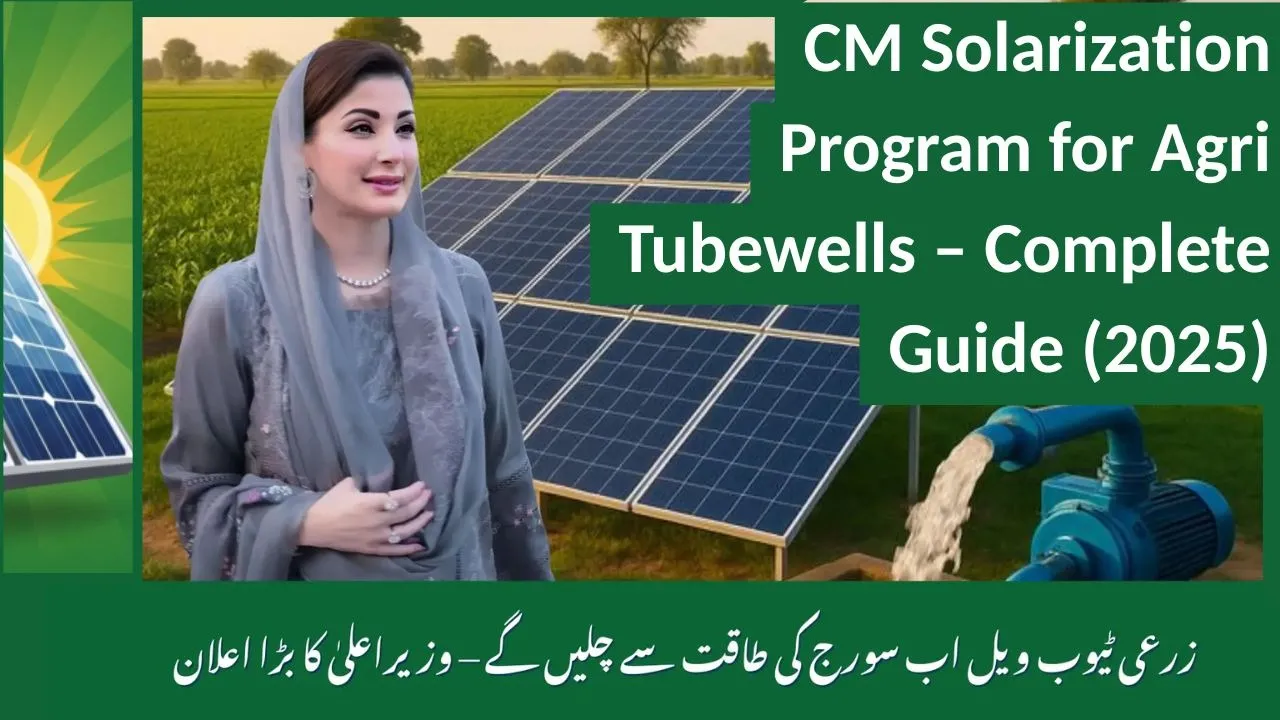Solarization Program for Agri Tubewells CM Punjab
CM Solarization Program for Agri Tubewells is the backbone of sustainable agriculture in Punjab, Pakistan, as of October 2025. Chief Minister Maryam Nawaz Sharif is committed to climate-resilient agriculture in the face of increasing energy costs and environmental pressures.
The program was launched in late 2024 under the Punjab Agriculture Department and has allocated Rs9 billion to convert 8,000 electric & diesel-powered tubewells to solar systems for smallholder farmers who are bearing the brunt of increasing fuel and electricity tariffs.
By October 2025, over 7,000 applications will have been processed, and balloting for the 2025 batch is expected to be completed in February. However, new phases may emerge as Punjab pushes for green energy. This guide is about official sources & will help farmers grow for future opportunities.
What is the CM Punajb Solarization Program for Agri Tubewells?
CM Solarization Program for Agri Tubewells is a government initiative launched in October 2024 to transition Punjab’s agricultural irrigation from fossil fuel-dependent tubewells to solar-powered systems, eco-friendly, and cost-effective farming.
Subsidy Details & Financial Structure
Subsidy is the backbone of the program; 40-50% of the total cost will be covered based on the system size, and the balance will be financed through a low-interest loan or self-funding. For 2025, the allocation is Rs 9 billion and will be distributed as follows:
| System Capacity | Subsidy Amount (PKR) | Total Estimated Cost (PKR) | Farmer’s Share (PKR) | Loan Option Available? |
| 10 KW (up to 5 HP pump) | 500,000 | 1,000,000-1,200,000 | 500,000-700,000 | Yes, up to 100% via Kisan Card (3% interest) |
| 15 KW (5-10 HP pump) | 750,000 | 1,500,000-1,800,000 | 750,000-1,050,000 | Yes |
| 20 KW (10+ HP pump) | 1,000,000 | 2,000,000-2,500,000 | 1,000,000-1,500,000 | Yes |
Eligibility Criteria: Who Can Apply?
Eligibility is farmer-centric so that the aid reaches the real small holders and is not misused. Applicants must be Punjab residents with at least 1 acre of irrigated land in the application district and a functional electric or diesel tubewell (installed before October 30, 2024, for electric).
Key requirements are a valid CNIC, proof of land ownership through Fard-e-Malakiat, and the last paid electricity bill (non defaulters only with 3-phase connection for electric tubewells). Diesel owners need engine registration and pollution certificates.
Exclusions are large farms (above 25 acres), government employees, and prior subsidy recipients. Priority will be given to women-headed households (30% quota), low-income groups (PMT score <45), and southern Punjab districts facing water scarcity.
CM Punjab Asan Karobar Scheme Phase 2 Apply Online
Application Process: How to Apply Online
- The online process, hosted on cmstp.punjab.gov.pk, is designed for accessibility and takes approximately 10-15 minutes to complete.
- Visit the portal, click on “Apply Now,” and register with your CNIC/mobile number for OTP verification.
- Select tubewell type (electric/diesel), capacity (10/15/20 KW), and upload documents: CNIC scan, Fard-e-Malakiat, tubewell bill/engine proof, and bank details for subsidy transfer.
- Submit and generate the application ID; no fee is applicable. For offline support, visit district agriculture offices or call 0800-17000.
Balloting / Selection Process
Due to high demand (over 20,000 applications for 8,000 slots in 2025), selection will be conducted through computerized balloting to ensure fairness. After a preliminary eligibility check, shortlisted applications (around 12,000) will go into a digital draw on the portal, which will be held publicly (e.g., January 31, 2025, for the batch). Results will be announced on 2 February 2025 and will be notified via SMS and posted on cmstp.punjab.gov.pk/ballot-results.
Winners will have 30 days to confirm and select vendors; non-responders will be given to waitlisted candidates. This balloting system, overseen by PEDA, ensures transparency, and audits prevent bias. The 2025 draw had 100% digital logging for appeals.
Capacity & Service Sizes Available
Systems are designed to match pump horsepower and farm requirements and are available in 10KW (5HP pumps, small farms), 15KW (5-10HP, medium), and 20KW (10+HP, large). Each includes 25-year panels, 5-year inverters, batteries for 4-6 hours backup, and remote monitoring. Installation by empaneled vendors (e.g., local solar firms) ensures IEC standards compliance with 5 5-year warranty.
Benefits & Impact for Farmers
Farmers get reliable, zero-fuel irrigation, reducing bills by 80-100% (Rs40,000-60,000/year) and 24/7 operation during peak season. Environmentally, it reduces CO2 emissions by 5-10 tons per tubewell per year, supporting Punjab’s net zero goals.
Economically, it increases yields (10-15% through consistent water) and income; 2025 pilots in Faisalabad showed a 20% revenue increase for the farmers. Socially, it empowers women farmers (30% quota) and reduces migration from rural areas.
How to Check Status & Contact Info
Track status on cmstp.punjab.gov.pk using your application ID—options show “Submitted,” “Verified,” “Balloted,” or “Approved.” SMS alerts supplement this. For queries, call helpline 0800-17000 (8 AM-8 PM, free) or email info@agripunjab.gov.pk. District offices handle escalations; in Lahore, visit the Agriculture Complex, Thandi Sarak.
Conclusion
CM Solarization Program for Agri Tubewells is very important for Punjab’s farmers, blending subsidies with tech for sustainable growth. Although the 2025 window has closed, the model promises continuous support for staying updated through the official site.
FAQs
Q. What is the deadline for applying?
Ans: 6 January 2025, for the 2025 batch is closed, but monitor for new phases.
Q. How much subsidy will I get depending on system size?
Ans: Rs500,000 (10KW), Rs750,000 (15KW), Rs1,000,000 (20KW).
Q. Can I choose my vendor/installer?
No, but you can select from 50+ empaneled vendors after approval.
Q. What documents do I need to attach?
Ans: CNIC, Fard-e-Malakiat, tubewell bill/engine proof.

